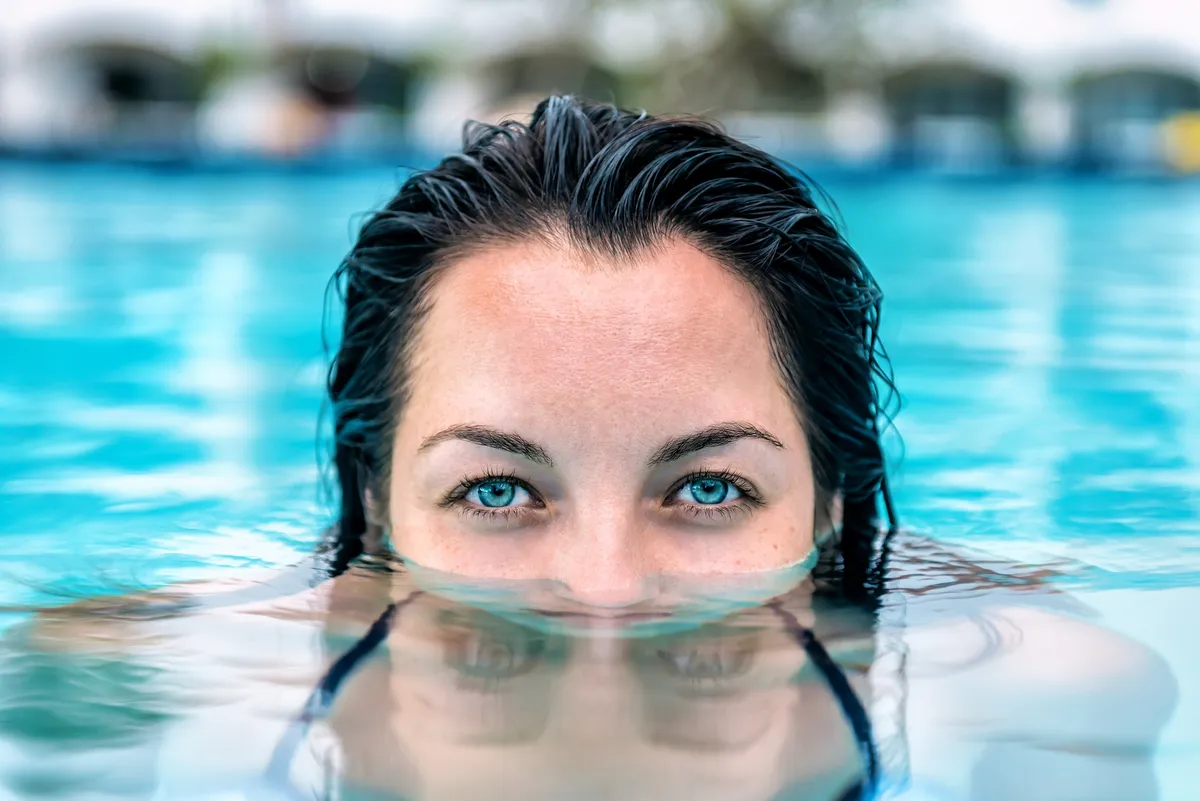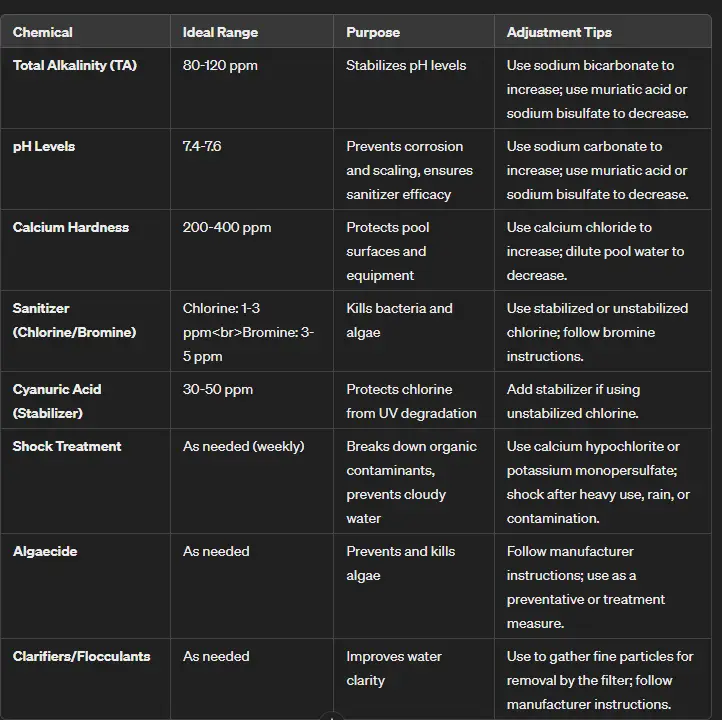Adding Chemicals to your pool should be done according to the most important to least important order relying on what works best by trial and experience but most of all try to be patient and not hurry, give the chemicals the time they need before moving on to the next step on the list. In What Order Do I Add Chemicals to My Pool?
- Alkalinity(80-140 ppm) wait time 4-8 hrs.
- Retest TA
- pH (7.2 -7.6 ) wait time 30 min.
- Retest pH
- Calcium Hardness-(200–400 ppm) wait time-30 min.
- Cyanuric Acid-(25-50 ppm) wait time 30 min.
- Shock the Pool-10 ppm wait time-4 hrs.
- Algaecide after shock wait time-5 days
- Clarifier-after algaecide wait time-5 days
This sequence is from my 30 years of opening, balancing, and putting the muscle back into the swimming pool’s water chemistry over the years this order can get your pool rock and roll fast.
What Order to Add Pool Chemicals
After you take the pool cover off, clean up the surrounding area, top off the water level, visit the Pool Supply Store, begin the work needed to open your swimming pool, and keep it clear and clean for the entire summer season. A method used by pool owners puts things into a rhythm of sorts brought on by the familiarity of seasons past.
I know because I have opened and run my inground pool for years. I just wanted to let you know what to expect. You know how many chemicals will get you through until Fall. You know what kind of chemicals you’ll need to open the pool and add for the first part of the season and those last “dog days of summer”
All this will depend on some variables like how bad the pool water looks after you pull the pool cover off. The mechanical operation of the pump and filter system and if all the pool tools like brushes and skimmers held up over the winter. When everything is operational from the sand filter to the GFI switches it’s time to adjust the pool water chemistry.
Once the pool is full or topped off after the long winter months and you remove the pool cover the sunlight that hits the water for the first time in 6 months can kickstart an algae bloom so as they say “times a wasting
How Long Do You Wait Between Adding Pool Chemicals?
All pool chemicals take their own time to mix and dissolve when added to pool water then changing the chemistry of the pool water but it all depends on the chemical’s active ingredients or strength …………………………………………………………………. Read more
Is It Necessary to Run The Pool Pump While Adding Chemicals
Testing Pool Water
Pool Chemical Tips
Additional Tips for Adding Chemicals:
- Always add chemicals to water, not water to chemicals.
- Run your pool pump and filter while adding chemicals to ensure proper distribution.
- Allow time for each chemical to circulate fully before retesting and adjusting further if needed.
Can I Add All My Pool Chemicals At the Same Time
No, it is not advisable to add all your pool chemicals at the same time. Each pool chemical serves a specific purpose and interacts differently with the water and other chemicals. Adding multiple chemicals simultaneously can lead to unwanted chemical reactions or the formation of harmful byproducts.
For example, mixing chlorine-based chemicals with acid-based chemicals can produce toxic chlorine gas. Additionally, adding chemicals all at once can make it challenging to accurately gauge and maintain the proper chemical balance in your pool.
It’s best to add chemicals one at a time, allowing each one to fully disperse and react before adding the next. This approach ensures that each chemical can effectively perform its intended function without interference. Always follow the manufacturer’s instructions for each chemical and allow sufficient time for proper circulation and mixing before retesting the water and making further adjustments. By adding pool chemicals sequentially and allowing adequate time for them to react, you can maintain a safe and balanced swimming environment for you and your family to enjoy.
Why Is It Important to Balance Total Alkalinity Before Adjusting Ph
Managing Calcium Hardness in Swimming Pools

Calcium hardness in pool water can increase due to various factors, primarily influenced by the source of water used to fill the pool and the addition of certain chemicals. Hard water sources, containing high levels of dissolved calcium and magnesium minerals, can contribute to elevated calcium hardness levels.
For pools in hard water areas, tap water of 400–600 ppm is not uncommon. The ideal range of 200–400 ppm is somewhat flexible, as many pools operate with much higher Calcium Hardness levels without a problem. If your water is soft, meaning levels are below 150–180 ppm, this can cause aggressive water conditions known to cause etching, staining, and mineral deposits. Add Calcium Hardness Increaser to raise Calcium Hardness levels in your pool. If your source water has naturally high Calcium Hardness, you can manage it with a stain and scale control product.
Additionally, using calcium-based products such as calcium chloride or calcium hypochlorite for pool maintenance can also raise calcium hardness levels over time. Evaporative concentration, where water evaporates from the pool surface but leaves the dissolved minerals behind, is another common cause of increased calcium hardness. High temperatures and low humidity accelerate this process, leading to a buildup of calcium hardness in the remaining water.
To manage elevated calcium hardness levels, several strategies can be employed. Diluting the pool water by partially draining and refilling it with fresh, lower-calcium water can effectively reduce calcium hardness levels. However, this approach is not always practical or feasible, especially in areas with limited water availability or where draining regulations apply. Another method is to use a commercial calcium reducer product specifically designed to lower calcium hardness levels in pool water.
These products typically contain chelating agents or sequestering agents that bind to calcium ions, preventing them from forming scale on pool surfaces. Regular monitoring of calcium hardness levels and taking preventive measures to avoid excessive calcium buildup can help maintain balanced water chemistry and prolong the lifespan of pool equipment and surfaces. Additionally, using a water softener or filtration system before filling the pool can help remove minerals responsible for hard water, reducing the likelihood of calcium hardness issues. By addressing the root causes of elevated calcium hardness and implementing appropriate management strategies, pool owners can ensure optimal water quality and extend the longevity of their pool infrastructure.
How Do You Know If Your Pool Needs Algaecide
You can determine if your pool needs algaecide by looking for specific signs of algae growth and considering preventive measures. Algae in a pool often appear as green, yellow, or black spots on pool surfaces, such as walls, floors, or steps. If you notice the water becoming increasingly cloudy or developing a slimy texture, this is another indication that algae might be present. Additionally, a strong, musty odor can signify algae blooms.
Here are key indicators that your pool needs algaecide:
- Visible Algae: Green, yellow, or black spots on surfaces.
- Cloudy Water: Persistent cloudiness despite regular cleaning.
- Slimy Surfaces: Pool walls and floor feel slippery or slimy.
- Musty Odor: Unpleasant, musty smell emanating from the water.
- Recurring Algae: Algae reappear quickly after cleaning.
Preventative use of algaecide is also advisable during periods of heavy pool use, high temperatures, or after heavy rains, as these conditions promote algae growth. Regular testing of pool water can help you catch imbalances that may lead to algae. If your pool consistently experiences algae problems despite maintaining balanced water chemistry, adding algaecide can provide an extra layer of protection.
Conclusion:
Regular testing of your pool water is crucial for maintaining its balance and ensuring safe swimming conditions. By following proper testing procedures and accurately interpreting the results, you can identify any imbalances or issues in your pool water chemistry.
This allows you to take timely corrective action, such as adjusting chemical levels or implementing other treatment methods, to restore optimal water quality. Keeping a record of your test results over time helps track changes and trends in water quality, enabling you to address potential problems before they escalate. Ultimately, by prioritizing regular testing and proactive maintenance, you can enjoy a clean, clear, and healthy pool environment for yourself, your family, and your guests to enjoy throughout the swimming season.
How Do You Make the Water in Your Swimming Pool Soft and Silky Smooth?
- By dropping levels of Calcium dissolved in the H2O using Muriatic Acid,
- Take Calcium out of the solution by Raising pH & Alkalinity to 10 pH in warm temps.
- Add Flocculant
- Circulate
- Let pool Sit
- Vacuum floc to waste
- Lower Alkalinity, pH with Muriatic Acid .…………………………………………………………………….. Read more

References:
In-the-Swim- Adding Chemicals at Start-up
FAQ’s
How often should I test my pool water? You should test your pool water at least twice a week. During periods of heavy use or extreme weather, testing more frequently can help maintain proper chemical balance.
What is the correct order to add pool chemicals? The recommended order is: adjust total alkalinity first, then pH levels, followed by calcium hardness, sanitizer (chlorine or bromine), cyanuric acid (if needed), shock treatment, algaecide (if needed), and finally clarifiers or flocculants (if needed).
What should I do if my pool water is cloudy? First, test and balance your pool chemicals, especially pH, alkalinity, and sanitizer levels. If the water remains cloudy, use a pool clarifier to gather fine particles or a flocculant to settle them for easier removal.
How often should I shock my pool? You should shock your pool weekly, or after heavy use, heavy rain, or if you notice the water is cloudy or has an unpleasant odor.
What is cyanuric acid and why is it important? Cyanuric acid is a stabilizer that protects chlorine from being broken down by UV rays from the sun. Outdoor pools need to use unstabilized chlorine to maintain effective sanitizer levels.



